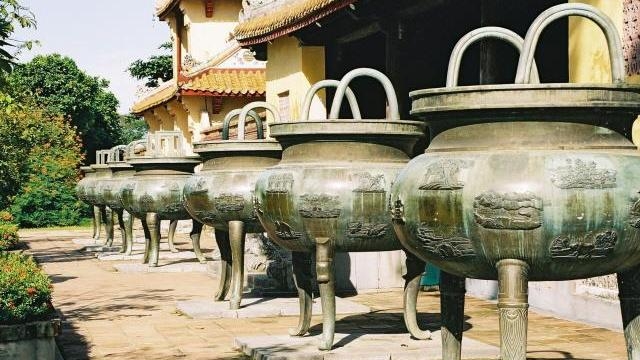The treasures include a collection of nine bronze urns and nine canons, the Great bell in Thien Mu pagoda, the King’s throne, Nguyen King’s royal robe, a stele engraved with the essay Khiem Cung Ky by King Tu Duc, and a collection of copper cauldrons.
The cannons, 5.1 metres in length and more than 10 tonnes in weight, were named after the four seasons and the five elements: Metal, Wood, Water, Fire, and Earth. Meanwhile, the nine urns, situated in the front of Hien Lam Pavilion, opposite The Mieu Temple, were cast under an order of King Minh Mang in 1835 to symbolise the sovereignty of the dynasty.
The 2,000 kg great bell of Thien Mu pagoda was cast during the rule of Lord Nguyen Phuc Chu in 1710. It was engraved with dragon and phoenix patterns.
The royal robe was worn by the Nguyen Kings at Te Giao ritual at the Nam Giao Esplanade, in which the King represented the entire nation to pray for favourable conditions, peace for the country and prosperity for the people.
The King’s throne in the Palace of Thai Hoa, Hue Citadel is a symbol of the dynasty’s power as it witnessed the ups and downs during the 143 years of the last feudal dynasty in Vietnam.
The stone stele, placed at King Tu Duc’s tomb, is 5 metres high and weighs 20 tonnes. The stele is engraved with the essay Khiem Cung Ky by the King, and a narrative of his life and accomplishments.
The nine cauldrons are a set of bronze censers, vessels used for burning incense, in central Hue imperial citadel.




